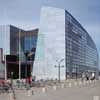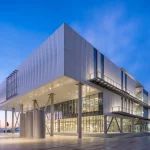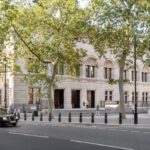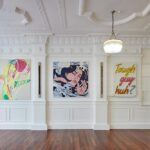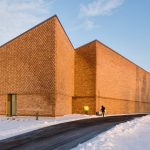Kiasma Museum of Contemporary Art, Helsinki, Architect, Finnish Architecture Project, Design, Picture
Kiasma Museum Helsinki
Contemporary Finnish Building News – design by Steven Holl Architects, USA
27 May 2010
Kiasma
National Finnish Modern Art Gallery
Dates built: 1993-98
Design: Steven Holl Architects
May 2008
Steven Holl’s Kiasma Museum Celebrates 10th Anniversary
Helsinki Museum of Contemporary Art
The site for Kiasma lies in the heart of Helsinki at the foot of the Parliament building to the west, with Eliel Saarinen’s Helsinki Station to the east, and Alvar Aalto’s Finlandia Hall to the north. The challenging nature of this site stems from the confluence of the various city grids, from the proximity of the monuments, and from the triangular shape that potentially opens to Töölö Bay in the distance.
The concept of Kiasma involves the building’s mass intertwining with the geometry of the city and landscape which are reflected in the shape of the building. An implicit cultural line curves to link the building to Finlandia Hall while it also engages a “natural line” connecting to the back landscape and Töölö Bay.
In the landscape plan, extending the bay up to the building will provide an area for future civic development along this tapering body of water, which also serves as a reflecting pool for Finlandia Hall and new development along the south edge of the water. The horizontal light of northern latitudes is enhanced by a waterscape that would serve as an urban mirror, thereby linking the museum to Helsinki’s Töölö heart, which on a clear day, in Aalto’s word’s, “extends to Lapland.”
The changes in elevation proposed with the water extension and it shallow depth would allow for parking decks and/or highway linkages which are presently part of various planning considerations.
This water extension from Töölö Bay intertwines with and passes through the museum. The rectangular pool along the west elevation is the source of a slow recirculating system which gradually lowers the water level. The gentle sound of moving water can be heard when walking through the cusp of the building section which remains open for passage year-round.
The ponds at Kiasma Museum of Contemporary Art are not intended to be drained. Instead, they are allowed to freeze in winter according to a detail first devised by Eliel Saarinen for the accommodation of the expansion of water during freezing. At night the west pond reflects the internal light radiating from the museum west pond which expresses a “spatiality of night.”
During the early evening hours of the winter months, glowing light escaping from the interior of the building along the west facade invites the public inside.
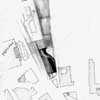
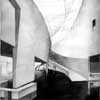
Helsinki Museum of Contemporary Art : sketch images Courtesy Steven Holl
The Helsinki Museum of Contemporary Art provides a variety of spatial experiences. Steven Holl Architects considered the range of contemporary artwork, and tried to anticipate the needs of a variety of artists including those whose works depend on a quiet atmosphere to bring out their full intensity.
An exhibition space that works for an expressive and unpredictable artist such as Vito Acconci, must also work for artist such as Agnes Martin and Richard Tuttle. The general character of the rooms, which are almost rectangular with one wall curved, allows for a silent yet dramatic backdrop for the exhibition of contemporary art. These rooms are meant to be silent, but not static; they are differentiated through their irregularity.
Particular to Helsinki is the horizontal natural light of the northern latitudes. The slight variation in room shape and size due to the gently curving section of the building allows natural light to enter in several different ways. This asymmetrically drives movement through a series of spatial sequences.
In this regard the overall design of Kiasma Museum of Contemporary Art becomes a slightly warped “gallery of rooms,” where the spatial flow emerges from the combination of the horizontal light-catching section and the continuity of the internal space. This curved unfolding sequence provides elements of both mystery and surprise – which do not exist in a typical single or double loaded orthogonal arrangement of space.
Instead, the visitor to Kiasma Museum of Contemporary Art is confronted with a continuous unfolding of an infinite series of changing perspectives which connect the internal experience to the overall concept of intertwining or Kiasma.
This open-ended spatial system suggests an expanse that lies beyond, in contrast to rectilinear organization and “centered” composition that dictates the viewer’s movement, or an expressionist dynamic that excludes the serenity necessary for viewing some types of work. The spaces of the intertwining curves in Kiasma avoid both the rigidity of a classical approach and the excessive complexity of expressionism.
The dynamic internal circulation, with its curving ramps and stairs, allows for an open interactive viewing, inspiring the visitor to choose his or her own route through the galleries. Unlike a hierarchical sequenced or ordered movement, this open-ended casual circulation provokes moments of pause, reflection, and discovery.
Another concept behind the Kiasma Museum of Contemporary Art building’s spaces is to create silence by eliminating the intermediate scale in the building’s architecture. In this way, the art work can occupy the intermediate scale in contrast with the neutral mass of the wall. Rather than articulating columns, moldings, window openings, etc., the architecture is expressed through details such as the twist of a door handle, the edge of a stair, the exposed thickness of a slab of glass.
A common problem in the design of an art museum with galleries on multiple levels is that the stacked section only permits natural light to enter the upper level galleries, leaving the lower levels exclusively dependent on artificial light. In the Museum of Contemporary Art, Helsinki, Steven Holl Architects address this problem in two ways.
First, the curved roof of Kiasma Museum of Contemporary Art allows secondary skylights while horizontal light is deflected down through the section along the center. Thus natural light is able to penetrate both upper and lower levels.
Second, the curved roof section with its “refracting” skylight introduces another means for distributing light to galleries below the top level. Because of the building’s curving and intertwining morphology, because of the interwoven torsion of space and light, Steven Holl Architects have allowed for the different levels to be naturally lit. There is a correspondence between the internal nearly rectangular spaces, and the exterior’s continuous uninterrupted surface.
Kiasma also serves as an “Art Forum,” open and flexible for staged events, performances, dance, music, and seminars. The particular placement of the cafe at ground level – open to both the garden and the lobby – makes it adaptable to informal events, such as poetry readings or “round table” discussions.
The auditorium, equipped with the latest video projection capabilities, has a continuous glass rear elevation, making it visible from the outside passage through the building. When there is a lecture taking place in the theater, this open view might draw in observers who are walking along the passage, to take part in the discussion.
With Kiasma, there is a hope to confirm that architecture, art, and culture are not separate disciplines but are all integral parts of the city and landscape. Through care in development of details and the materials, the new museum provides a dynamic yet subtle spatial form, extending towards the city in the south and the landscape to the north.
The geometry has an interior mystery and an exterior horizon which, like two hands clasping each other, form the architectonic equivalent of a public invitation. Referring to the landscape the interiors are reversible; and form the site which, in this special place and circumstance, is a synthesis of building and landscape…a Kiasma.
Kiasma Museum of Contemporary Art Building info from Steven Holl Architects 230508
Helsinki Art Gallery architects : Steven Holl
Location: Kiasma, Helsinki, Finland, northeast Europe
New Helsinki Architecture
Contemporary Finnish Architecture
Helsinki Architecture Designs – chronological list
Helsinki Architecture Walking Tours
Amos Rex, Mannerheimintie
Design: JKMM Architects
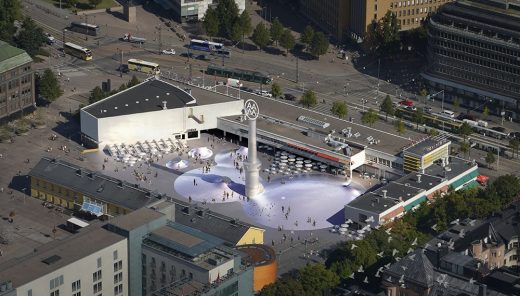
images courtesy of architects office
Amos Rex
Helsinki Architect – design firm listings
Art Gallery Designs by Steven Holl Architects – Selection
Finnish Architecture
Helsinki City Museum, the Tori Quarters
Design: Arkkitehdit Davidsson Tarkela
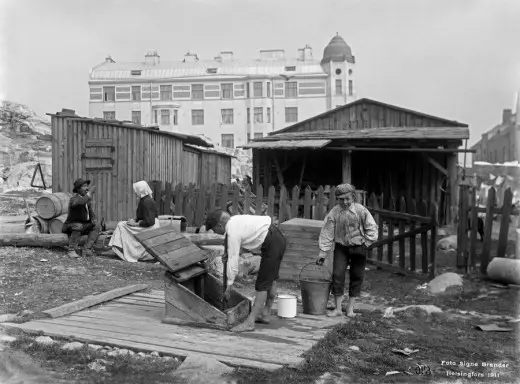
image Courtesy architecture office
Helsinki City Museum Building
Buildings in Finland – alphabetical list
Comments / photos for the Kiasma Museum of Contemporary Art Building page welcome
Website: www.kiasma.fi

